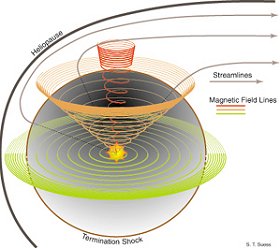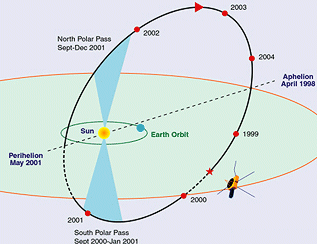|
Using data from the Ulysses spacecraft, researchers
have discovered that high-energy particles from the Sun sometimes
go in unexpected directions.
by Dr Tony Phillips
Take a piece of paper. Make a little wad. If you're
a kid, spit on it. Put it in a straw and blow hard.
If your teacher sends you to the principal's office,
here's your excuse: you were making a model of relativistic protons
accelerated in the shock front of a solar coronal mass ejection
(CME). It was done in the name of science.
Really. Solar explosions and spitwads
do have something in common. CME's hurl subatomic particles across
the solar system at nearly light speed. Those particles are guided,
much like a spitwad in a straw, by the Sun's magnetic field.
The Sun is a star-sized magnet; its magnetic field
permeates the solar system all the way from Mercury to Pluto and
beyond. We don't feel it on Earth only because our planet's own
magnetic field is locally stronger - but in interplanetary space,
the Sun's magnetic field rules.
Because the Sun rotates on its axis (once every
27 days) the Sun's magnetic field out among the planets has a spiral
shape. Researchers call it "the Parker spiral" after the physicist
who first described it. Using the Parker spiral, "space weather
forecasters can predict where energetic solar particles will go,"
explains solar physicist Ming Zhang of the Florida Institute of
Technology. That's a good thing, say, for spacewalking astronauts
who want to know when a radiation storm is coming so they can duck
inside their spaceship.
But Zhang and colleagues have recently discovered
something troubling. Solar particles don't always follow the Parker
spiral like they're supposed to.

Credit: Steve Suess, NASA.
The Sun's
spiraling magnetic field as viewed from ~100 AU
away.
|
"We learned this," says Zhang, "using the Ulysses
spacecraft."
Ulysses is a joint mission of the European Space
Agency and NASA to study the Sun. The spacecraft left Earth in 1990
and swung by Jupiter two years later - an encounter that flung the
craft high above the orbital plane of the nine planets. Ulysses'
looping orbit carries it all around the Sun, even over the Sun's
poles, which is just what scientists wanted.
"Here on Earth we see the Sun from one direction
only - its equator," explains Zhang. "Ulysses lets us look at solar
activity from many directions."
Such was the case on July 14, 2000 - Bastille Day
in France - when a powerful explosion rocked the Sun. The source
was a sunspot 20 times wider than Earth itself. For days, magnetic
field lines above the spot had become increasingly tangled. The
tension grew until, like a rubber band stretched overly taut, the
lines of force snapped back - explosively.
A blast of electromagnetic radiation caused radio
blackouts on Earth for hours. The explosion also hurled a massive
cloud of gas (a CME) toward Earth, which, when it swept past our
planet two days later, would trigger auroras as far south as Texas.
At the leading edge of the CME, a shock wave accelerated subatomic
particles to nearly light speed. Magnetic lines of force guided
them to Earth where they temporarily disabled some satellites and
knocked out one (the Japanese Advanced Satellite for Cosmology and
Astrophysics) completely.

The high
polar orbit of Ulysses carries it to a maximum solar latitude
of 80.2 degrees south.
|
Ulysses watched these events from high
(3 AU)
above the Sun's southern hemisphere. "The spacecraft was at 60o
S heliographic latitude. The explosion was at 22o N -
almost directly in line with Earth," says Zhang. You can visualize
it this way: Suppose the Sun had continents and countries like our
planet does. The explosion happened in Saudi Arabia; Earth was overlooking
equatorial Kenya; and Ulysses was hovering above the Antarctic Peninsula.
Ulysses' point of view, looking sideways at an explosion
that blasted Earth nearly head-on, was key to Zhang's discovery.
Although the blast wasn't directed toward Ulysses,
the craft was connected to the expanding CME by solar magnetic field
lines. "At first, protons accelerated by the CME arrived from the
direction we expected," says Zhang. "They followed the Parker spiral."
But a few hours later Ulysses was blindsided by a blast of protons
from 90o away.
The spitwad had tunnelled through the
straw!
"The technical name for this is cross-field diffusion,"
says Zhang. "It happens when magnetic fields get tangled." Particles
find themselves able to drift or "diffuse" from one twisted line
of force to another. "Pretty soon they're moving in unexpected directions,"
he says.
That's troubling, says Zhang, because
subatomic particles accelerated by CME's can be "worse than radiation
from nuclear bombs." Forecasting where those particles will go is
crucial to the safety of astronauts and satellites. Nanosatellites,
a new kind of miniature spacecraft on the drawing board, are particularly
vulnerable, says Zhang. Their tiny electronics can be disabled by
a single solar proton ("heavy ions are even more effective," he
notes) - although nanosatellites can survive a radiation storm simply
by turning off sensitive systems until the storm subsides.

more
Spacewalking
astronauts need good forecasts of solar radiation storms.
|
Researchers have developed computer
models to predict the onset of radiation storms after solar flares
and CME's, "but seldom do they include cross-field diffusion," says
Zhang. "It is difficult to include," he explains, "because cross-field
diffusion is a complicated process that happens in places where
magnetic fields are tangled - in other words, where the Parker spiral
is not quite right." Most of the solar system is unexplored territory,
so researchers don't know where the tangles are.
Researchers have developed computer
models to predict the onset of radiation storms after solar flares
and CME's, "but seldom do they include cross-field diffusion," says
Zhang. "It is difficult to include," he explains, "because cross-field
diffusion is a complicated process that happens in places where
magnetic fields are tangled - in other words, where the Parker spiral
is not quite right." Most of the solar system is unexplored territory,
so researchers don't know where the tangles are.
"We've still got a lot to learn," he concludes.
How does cross-field diffusion work? Where is it most likely to
happen? With some help from Ulysses, "we're finding the answers."
|
